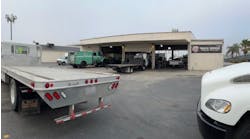Fifty-year-old truck shop shares technician retention tips
In this article, you'll learn:
- Bascom Truck & Auto's hiring techniques for new and veteran technicians
- How the small shop retains its employees for decades
- How to leverage technician pay to increase productivity
Financing new hires
For standard new hires, Bascom noted that there’s a fine balance to consider when it’s time to hire a new technician, with factors such as the shop's workload, overtime, turned-away work, and investment capital.
“My point is that when we hire a person, we have to have the capital to be able to fund that hire,” he said.
However, guaranteeing that the new technician will immediately have their hands full of work isn’t one of Bascom’s hiring considerations. Instead, if he thinks the shop can financially handle a new hire, they’ll do it, “because we find that when we have the extra staff, we will accept more work when it comes along than if we didn't have that staff. And so pretty soon, that person's completely busy.”
This is partially because Bascom aims to have his technicians maintain high productivity levels (and why the 11,000 sq.-ft. shop wasn't cutting it). When discussing productivity, the shop refers to a tech's utilization vs. billable hours.
McWilliams said that "We want [the utilization rate] to be 90% or above. And then of the time they're clocked onto a ticket, we want to bill 90% of that or above."
As for the hiring process itself, this, too, is an investment for the shop, McWilliams said. The siblings use a combination of processes when making a new hire, including a mechanical aptitude test and a behavior assessment, called Job Behaviors, to see if they’ll fit the culture. Then, they give candidates a shop tour so that they can see the types of vehicles they would work on—which is almost everything.
“Anything under the sun could be [in the shop],” McWilliams stated. “And that's not right for everybody, but it is right for some.”
Finally, the prospective technician also has interviews with Mike Bascom, McWilliams, and the manager they’d be working with. While this process is long, according to the Bascoms, their thoroughness has meant that they don’t generally need to fire people.
“Most of the time, when people leave, I think it's a generational thing, rather than the shop culture,” the GM said.
Customer management
Of course, the other side of Bascom's growth and the benefits he offers his technicians is making sure he treats his customers right, too. In particular, this means that the shop needs to be careful when setting its labor rates. While some shops might look to their competition to understand how much they should charge, Bascom doesn’t prefer this method.
“The challenge with [that] method … is that assumes that my competition knows how to set their rates, and I'm not so confident that they do,” he quipped.
Instead, Bascom monitors his shop’s fixed and variable costs, ranging from employee pay to taxes. He also wants to ensure his investments in his shop and equipment are making a proper return and that the shop is turning a fair profit. By adding those elements together and dividing that among the number of hours the shop’s historically been able to sell, Bascom determines what he thinks he needs to charge per hour.
“Then we take that number and we look at the competition and say, ‘Does that compete in the market?’” he asked. “If it does compete in the market, we're on our way.”
Then there’s the delicate question of how to handle customer relations while still holding to the operational math he’s done.
As an example, Bascom told the story of how three of their freight customers, who were each receiving a discounted rate, merged into one, becoming 30% of Bascom’s business at the time. Reportedly, the fleet’s maintenance manager came to Bascom asking for a better rate and proposed one that Bascom knew was below their operating costs. The fleet argued that the number of work hours they’d bring in would make the rate worth it, but Bascom held firm.
“We had to hold the line, because if we had just looked at the volume of revenue that they would bring in, without regard to what it cost us to get that revenue, then we would have operated at a loss every time we worked on their trucks, and we wouldn't be able to sustain that,” he said.
So, the company went elsewhere. Bascom was transparent with his technicians about what was happening and explained why he had to limit their hours to no more than 40 while they filled the gap, but fill it they did.
“Now all three of those freight companies are gone, and we're still there,” Bascom concluded. “You have to have the courage to make decisions that will keep you profitable, even though it may cost you revenue in the short run.”






